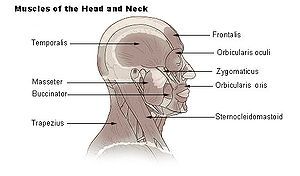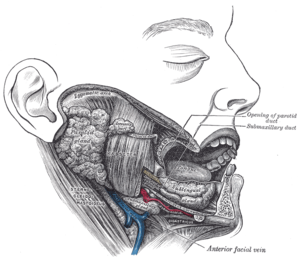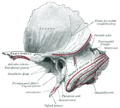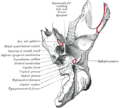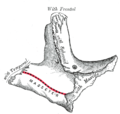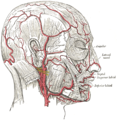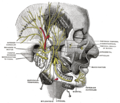- Masseter muscle
-
Masseter Muscles of the head and neck. Dissection, showing salivary glands of right side. (Masseter visible at center.) Latin musculus masseter Gray's subject #109 385 Origin zygomatic arch and maxilla Insertion coronoid process, ramus of mandible, cementomaxillary tendon and cementomandibular tendon Artery masseteric artery Nerve mandibular nerve (V3) Actions elevation (as in closing of the mouth) and protraction of mandible Antagonist Platysma muscle In human anatomy, the masseter is one of the muscles of mastication.
In the animal kingdom, it is particularly powerful in herbivores to facilitate chewing of plant matter.
Contents
Origin and insertion of the two heads
The masseter is a thick, somewhat quadrilateral muscle, consisting of two parts, superficial and deep. The fibers of the two portions are continuous at their insertion. The masseter muscle is sometimes the target of plastic jaw reduction surgery.
Superficial
The superficial portion, the larger, arises by a thick, tendinous aponeurosis from the zygomatic process of the maxilla, and from the anterior two-thirds of the lower border of the zygomatic arch. Its fibers pass downward and backward, to be inserted into the angle and lower half of the lateral surface of the ramus of the mandible.
Deep
The deep portion is much smaller, and more muscular in texture. It arises from the posterior 3rd of the lower border and from the whole of the medial surface of the zygomatic arch. Its fibers pass downward and forward, to be inserted into the upper half of the ramus and the lateral surface of the coronoid process of the mandible.
The deep portion of the muscle is partly concealed, in front, by the superficial portion; behind, it is covered by the parotid gland.
Innervation
Along with the other three muscles of mastication (temporalis, medial pterygoid and lateral pterygoid), the masseter is innervated by the mandibular division of the trigeminal nerve.
Additional images
See also
External links
- LUC mass
- -100270003 at GPnotebook
- Masseter+muscle at eMedicine Dictionary
List of muscles of head and neck: the head (TA A04.1, GA 4.378) Extraocular (CN III, IV, VI) oblique (inferior, superior) · rectus (superior, inferior, medial, lateral) · levator palpebrae superioris (superior tarsal)Mastication (CN V3) masseter · temporalis (sphenomandibularis) · pterygoid (lateral, medial)
fascia: Masseteric fascia · Temporal fascia · Deep portion: cementomaxillary tendon · Superficial portion: cementomandibular tendonFacial (CN VII) levator anguli oris · levator labii superioris · zygomaticus (major, minor)
orbicularis oris · risorius · buccinator
depressor anguli oris · depressor labii inferioris · mentalisPalate/fauces (CN IX, X, XI)
(except TVP=V3)veli palatini (tensor, levator) · musculus uvulae · palatopharyngeus (to pharynx) · palatoglossus (to tongue)Tongue (CN XII) extrinsic (genioglossus, hyoglossus/chondroglossus, styloglossus, and palatoglossus) · intrinsic (superior longitudinal, inferior longitudinal, transverse, vertical)Categories:- Muscle stubs
- Muscles of the head and neck
Wikimedia Foundation. 2010.

